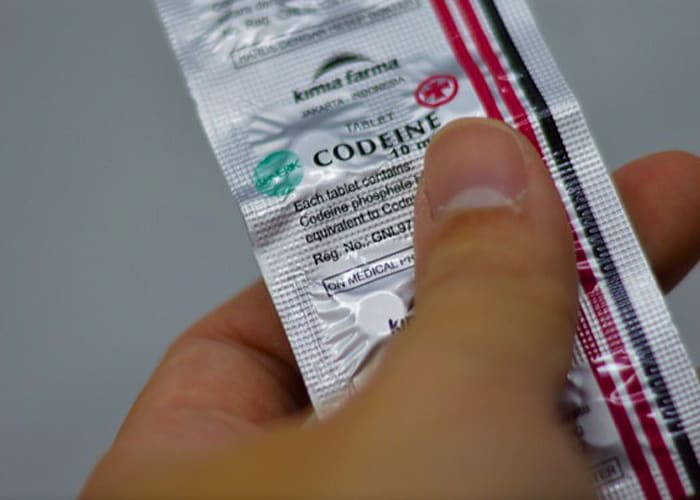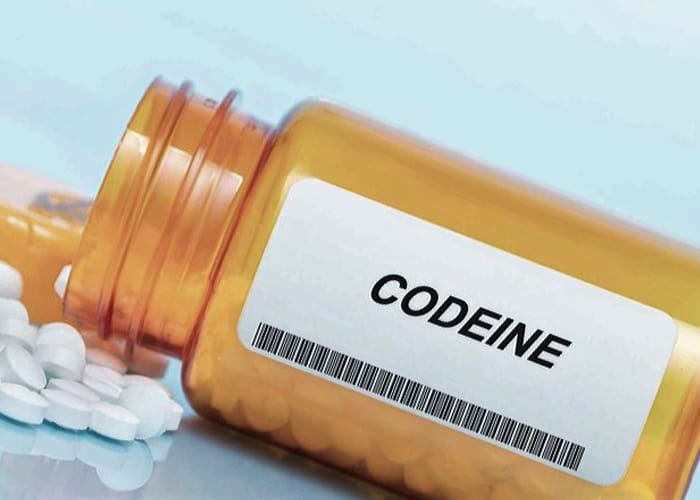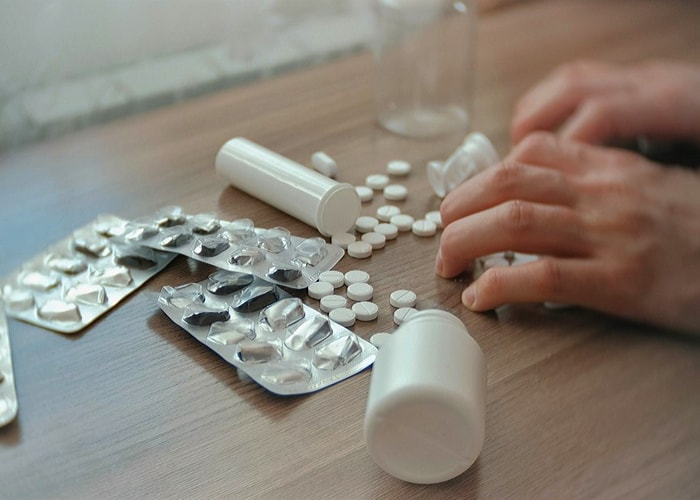What Is Codeine?
Pronounced as [koh-deen]
Codeine is a prescription opioid medication used to treat mild to moderate pain as well as to reduce coughing. Codeine is a naturally-occurring alkaloid derived from resin extracts from the seeds of the opium poppy. They belong to a class of drugs known as opioid analgesics.
Codeine is available as codeine tablets, capsules, and syrups in various strengths. It is also often combined with other medications like acetaminophen, ibuprofen, and in other medications such as cough & cold medications. A drug combination is known as a combo product and can help reduce pain more effectively than codeine alone.

Opioid analgesics like codeine may seem harmless to many, but not a lot of people are aware that in the United States, codeine is actually a Schedule II controlled substance.
This means that abusing an opioid medication like codeine tablets or syrup can lead to physical dependence, addiction, and other adverse effects. While codeine may still be available in some over-the-counter drugs in other countries, this opioid drug is a controlled substance in the United States.
What Are the Other Names for Codeine?
Codeine is an opioid medication that is available in the following generic and brand names:
- Aspirin and codeine: Aspalgin®, Codral Cold & Flu Original®
- Ibuprofen and codeine: Nurofen Plus®
- Paracetamol and codeine: Panadeine Forte®, Panamax Co®
- Paracetamol, codeine, and doxylamine: Mersyndol® and Mersyndol Forte®, Panalgesic®
- Codeine sulfate tablets
- Codeine phosphate tablets

What Are the Street Names for Codeine?
With opioid use disorder now increasingly rampant in the United States, illegal trading of opioids including codeine has also increased. Street names are used to disguise illicit opioid drug use.
Street Names of Codeine:
- Captain Cody
- Cody, Schoolboy
- Codeine syrup mixed with alcohol:
- Lean
- Sizzurp
- Purple Drank
- Codeine mixed with the sedative Glutethimide:
- Doors and Fours
- Loads
- Pancakes and Syrup
What Are Codeines Used For?
Codeine has been used in clinical medicine for more than a century and has proven its effectiveness over time. There are different uses for codeine but the two most common reasons for taking codeine are for pain relief and to suppress cough.

Mild to Moderate Pain
Codeine is used as an oral analgesic to treat mild to moderate pain. Taking codeine can also provide relief from moderately severe pain (when combined with aspirin or paracetamol) and colds and flu (when combined with antihistamines and decongestants).
Cough Suppressant
In low doses, codeine also works as an antitussive for the suppression of nonproductive cough which is why it is used as the main ingredient in prescription-grade cough suppressants. Codeine is used to help treat symptoms of acute cough and even chronic cough.
However, it must be remembered that this codeine is only a cough suppressant. This means that the main issue that causes the cough itself is not treated.
Because of this, some doctors believe that using a cough suppressant such as codeine could make the patient’s condition worse, as it interferes with the body’s intention of trying to clear some kind of obstruction from the airways.
Recreational Use
This pain relief medication is also unfortunately used as a recreational drug. Because codeine is an opioid, it can give off sedative effects to the user. Codeine cough syrup used to treat pain is often mixed with soft drinks and is referred to as "purple drank" or "lean", and users of this combination may report feeling a sense of euphoria.
It is important to note that codeine can be highly dangerous when taken in large amounts or by someone without medical supervision. If you drink alcohol or take other medications while taking codeine can lead to adverse effects such as respiratory depression, difficulty breathing, drowsiness, confusion, seizures, etc. Call your doctor immediately in case you encounter these symptoms.
How Does Codeine Work in the Brain and Nervous System?
Codeine works in the same way as any other opioid, affecting your brain and nervous system. Codeine disrupts your brain’s opioid receptors, lessens your perception of pain, and floods your brain with dopamine, causing calmness and euphoria. This is why codeine is used to treat pain.
Codeine is a distinctly selective agonist for opioid receptors, particularly the mu opioid receptor. Codeine binds to the mu opioid receptor, which are opioid receptors that play a critical role in sending pain signals throughout both the peripheral and central nervous systems.
This action hyperpolarizes the neuron, which reduces the release of nociceptive neurotransmitters and makes the person feel less pain. However, the effect of codeine on this receptor pales in comparison to morphine - an even more powerful opioid.

Cytochrome p450 2D6 and Codeine
Codeine is broken down in the body by a process called conjugation, resulting in morphine (5-10%) and N-demethylation to norcodeine (10%). Cytochrome P450 2D6 predominantly converts codeine into morphine while P450 3A4 primarily changes it into norcodeine.
How Strong is Codeine?
Codeine is less potent than most other opioids. Codeine is relatively weak in its potency compared to morphine with a potency ratio with oral morphine of 0.1. This means that you will need a 100mg dose of codeine to get an equivalent effect from 10mg of oral morphine.
This is the reason why the types of pain codeine treats are mostly mild to moderate. However, just because codeine is a weaker opioid, it does not mean that it's not addictive or will not result in adverse effects. When combined with other substances like alcohol, benzodiazepines, central nervous system stimulants, and other drugs, codeine can still be highly addictive.
Some of the more serious consequences of codeine and opioid abuse include life-threatening respiratory depression, kidney disease, liver disease, and death.

How Long Does Codeine Stay in Your System, Blood, Urine, Saliva, Hair?
Are you taking a drug test soon? If so, you're likely wondering how long codeine stays in your system. The amount of time codeine remains can vary depending on several conditions.
The amount of codeine consumed, the frequency at which it was used, and how long you have been using codeine all contribute to determining how much time it will stay in your system.
Additionally, factors such as metabolism rate, body weight, and age can influence the duration that codeine remains present in your body. Your organ's capacity is also a factor.
Codeine also has a half-life of 2.5 to 4 hours. This simply means that your body will take somewhere around 2.5 to 4 hours to process half of the ingested codeine drug in the blood’s plasma.
Codeine and its salt swiftly pass through the gastrointestinal tract, allowing peak plasma concentrations to take effect after only an hour of ingestion. Around 90% of codeine is excreted via the kidneys, with roughly 10% remaining as unchanged codeine.
The amount of time codeine can be detected in drug tests will depend on the type of drug test.
- Blood test: 24 hours
- Urine test: 1 to 3 days
- Saliva test: up to 4 days
- Hair test: 90 days
What Are the Side Effects of Codeine Use?
Because it is less potent than most other opioids, it is also less regulated. That means getting and abusing codeine is relatively easy even if it's not to relieve pain. Its most common side effects include those that can also be seen from the side effects of most opioid drugs.
Since it is easier to have access to this pain relief drug, codeine's effects are commonly abused to help manage stress and depression. However, using any type of drug just for the feeling of euphoria to escape negative emotions greatly increases the risk of being dependent on that drug.
Its long-term use can cause symptoms like anxiety and depression so these types of codeine should never be used to treat mental illness.

Short-term Side Effects
- Agonizing nausea
- Persistent vomiting
- Stomach pain
- Constipation
- Distinguishable pinpoint pupils
- Breathing problems such as shallow breathing, trouble breathing, noisy breathing, difficult breathing
- Exhaustion or even unconsciousness
- Heart or blood pressure irregularities
- Memory impairment and difficulty thinking clearly
- Dry mouth
- Severe dizziness
- Profuse perspiration
- Migraines and headache
- Extreme sleepiness
- Profound sedation
Long-Term Side Effects
- Life-threatening intestinal obstructions or tears
- Potential for permanent damage to the kidneys, liver, eyes, and the brain
- Memory problems and cognitive issues
- Breathing problems can cause a decrease in oxygen flow and damage to the brain
- Vision problems
- Reduced sex drive
- Irregular menstrual cycle
- Muscle twitches
- Addiction as the drug codeine is habit-forming
Possible Drug Interactions:
Taking codeine without a proper prescription is dangerous. That's because you might be unknowingly taking it with other drugs such as CNS depressants or muscle relaxants that can cause serious adverse reactions. You may also have pre-existing conditions that can affect how codeine reacts to your body. In addition, the drug is also habit-forming.
Before taking codeine, inform your doctor if you have existing conditions such as breathing problems, migraine headaches, kidney disease, liver disease, COPD, breathing problems (shallow breathing, noisy breathing, difficult breathing), or mental illness. Having a mental illness like depression, anxiety, or PTSD should be disclosed to your doctor.
If you are taking other drugs for migraine headaches, mental illness, muscle relaxants, antihistamines, selective serotonin-reuptake inhibitors, or any other prescription medication, make sure to inform your doctor.

Codeine should not be administered to pediatric patients or children younger than 12 years old as well as adolescents between the ages of 12 and 18 who have elevated risk factors for breathing problems and respiratory depression, such as obesity, lung disease, or obstructive sleep apnea. Sleep apnea is a condition wherein a person’s breathing temporarily stops while sleeping, leading to impaired oxygen levels in the brain. Over-the-counter medicines should be considered instead of codeine or codeine-containing drugs.
If you are taking other medicines that affect serotonin levels and then you are taking codeine as well, this could result in a condition called serotonin syndrome. Some symptoms of serotonin syndrome may include muscle spasms, anxiety, fever, fast heart rate, nausea, twitching, and more.
If you experience any respiratory depression , breathing problems, or profound sedation while taking codeine, seek emergency medical attention immediately. Emergency medical help can save you from a life-threatening respiratory depression.
How is Codeine Abused as a Drug?
Codeine is most easily accessible in codeine cough syrups which makes abusing it in this form easier. It is used in this form to make what is called “purple drank” by mixing prescription-grade codeine cough syrup with soft drinks such as Sprite or Mountain Dew.
This purple drank has become very popular in pop culture by being referenced and mentioned in multiple songs and TV shows.
In some countries, codeine can be bought over the counter. An over-the-counter medicine means you won't need a prescription to get it. This makes it easier for some people, especially teens to abuse codeine by buying these over-the-counter drugs that contain codeine.

How Does One Get Addicted to Codeine?
Long-term use of codeine can be habit-forming by producing cravings and a psychological desire to keep on using it. Tolerance is also a big factor in addiction.
When the body develops a tolerance for codeine or another habit-forming drug, the patients have to take a higher dosage to get the same effects as the first time that they have taken it. This can lead to overdose if not addressed properly by a doctor.
Some patients become addicted to opioids like codeine after experiencing what may seem like life-threatening withdrawal symptoms from other stronger substances. Because of this, they sometimes tend to continue taking codeine and other opioids to self-medicate.
Since codeine is less powerful or addictive than other opioids, it can give users a false sense of security. Because of this, codeine is said to be a gateway drug to other opioids, including morphine and even heroin.
Make sure to follow the prescription label when taking codeine. Do not take more than what is indicated on your prescription label or what your healthcare provider instructed. If you have a missed dose, do not double the missed dose on the next dose to avoid the risk of overdose. Skip the missed dose instead or call your doctor for proper advice.
What Causes Codeine Overdose?
Abusing codeine, especially if you do not have a proper prescription can be dangerous. Aside from addiction, abusing codeine can lead to risk factors like respiratory depression, profound sedation, and drug overdose which can be life-threatening.
Overdose can also occur if you drink alcohol and take codeine. This combination can cause you to get drowsy and have breathing problems like shallow breathing or difficulty breathing.
Other negative effects of mixing it with alcohol or other medicines are drowsiness or fatigue, dizziness, headaches, mental “fog”, trouble concentrating, profound sedation, delayed motor skills and reaction time, impairment of thinking and judgment, respiratory depression, and coma.

In the worst case scenarios, it can turn into a fatal respiratory depression where you could collapse and die. This life-threatening scenario is highly possible if the amount of either codeine or alcohol is sufficiently high.
Mixing codeine with other medications like benzodiazepines, central nervous system stimulants, and other opioid drugs can also result in respiratory depression and can be life-threatening.
Overdose can also happen if you take counterfeit opioids so make sure you only buy your prescription medicines from licensed health system pharmacists. Contact a doctor immediately in case of a drug overdose.
What Are Codeine Overdose Symptoms?
When you overdose on codeine, you will notice adverse reactions and these can even be life-threatening. Contact a healthcare provider immediately if you see any of these symptoms.
Signs of overdosing on codeine may consist of the following adverse effects:
- Abnormally colored urine, such as dark hues
- Pallid or sky-blue lips, nails, and skin
- Pinkish frothy sputum due to coughing fits
- Difficulty breathing that can range from slow and shallow breaths to fast ones
- Abdominal pain in the upper stomach area accompanied by queasiness and vomiting episodes
- Clammy skin texture
- Pinpoint-sized pupils for eyes
- Jaundiced coloration around the eyes' circumference or entire complexion
How to Treat Codeine Overdose?
Call for emergency medical attention or emergency medical help from a healthcare provider if you or someone else you know is experiencing an overdose of codeine. It is also important to report the amount of codeine taken and any other drugs that may have been ingested to the emergency medical personnel.
Emergency medical personnel may use an opioid-reversal drug such as naloxone (Narcan) to counteract the effects of a codeine overdose.
What Are the Withdrawal Symptoms of Codeine?
If you suddenly stop taking opioids like codeine, you may experience withdrawal symptoms. The common withdrawal symptoms from this codeine addiction include nervous tremors, stomach cramps, anxiety, yawning, sweating, runny nose, sleep disturbance, nausea, diarrhea, goosebumps, restlessness, dizziness, tiredness, confusion, difficulty concentrating, euphoria, blurred vision, dry mouth, mild allergic rash, itching and hives, decreased heart rate, palpitations, difficulty urinating, abdominal cramps and muscle spasms.

How to Treat Codeine Addiction
While emergency medical attention may help treat a codeine overdose, it is much more challenging to overcome opioid addiction. To treat opioid addiction, a comprehensive addiction treatment program is recommended.
Codeine addiction treatment usually begins with a detoxification period at an inpatient treatment center. When opioid addiction is severe or if the person is struggling with an addiction to multiple drugs and alcohol, it might feel like you're experiencing life-threatening withdrawal symptoms. When you go through medical detox, it can help make these life-threatening withdrawal symptoms less severe. A drug called Suboxone is also used to relieve these withdrawal symptoms.

Besides medical care, inpatient facilities also provide group counseling and specialized support to help recovering patients learn to live a normal life without codeine. If you are struggling with a co-occurring mental illness, a dual diagnosis treatment is recommended.
Like with many drug addiction treatments, being in a very supportive community that understands the patient’s situation can drastically increase the chance of full recovery.
Rehabilitation programs in these inpatient centers typically last for 30 to 90 days depending on the severity of the patient’s condition.





